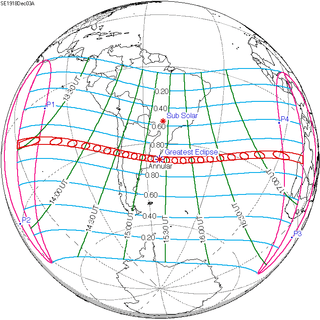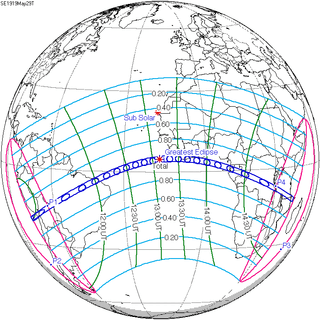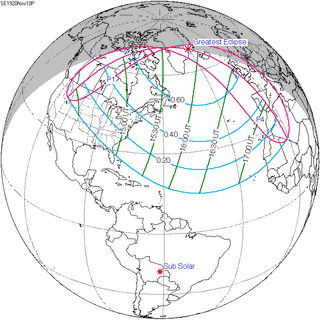Solar eclipse of June 8, 1918
| Solar eclipse of June 8, 1918 | |
|---|---|
 Map | |
| Type of eclipse | |
| Nature | Total |
| Gamma | 0.4658 |
| Magnitude | 1.0292 |
| Maximum eclipse | |
| Duration | 143 sec (2 m 23 s) |
| Coordinates | 50°54′N 152°00′W / 50.9°N 152°W |
| Max. width of band | 112 km (70 mi) |
| Times (UTC) | |
| Greatest eclipse | 22:07:43 |
| References | |
| Saros | 126 (42 of 72) |
| Catalog # (SE5000) | 9324 |
A total solar eclipse occurred on June 8, 1918. The eclipse was observed by a U.S. Naval Observatory team at Baker City in Oregon. The painting below shows totality when the moon prevented the sun's rays from hitting that part of Oregon. The track of the eclipse went across the United States.
The path
The path of the eclipse started south of Japan, went across the Pacific Ocean, and then across the United States. The largest city to see totality was Denver although many could theoretically see it as the size of the shadow was between 70 and 44 miles (113 and 71 km) across as it travelled across America. The longest duration of totality was in the Pacific at a point south of Alaska. The path of the eclipse finished near Bermuda.[1]
U.S. Observation team

The path clipped Washington State and then moved across the whole of Oregon and then the rest of the country exiting over Florida. The U.S. Naval Observatory obtained a special grant of $3,500 from Congress for a team to observe the eclipse in Baker City in Oregon. The team had been making preparations since the year before and John C. Hammond led the first members to Baker City on April 11th.[2] The location was important as it influenced the probability of cloud cover and the duration and angle of the sun during the eclipse. The team included Samuel Alfred Mitchell as its expert on eclipses, and Howard Russell Butler, an artist and physicist. In a time before reliable colour photography, Butler's role was to paint the eclipse at totality after observing it for 112.1 seconds.[3] He noted later that he used a system of taking notes of the colours using skills he had learnt for transient effects.[3]
Observation
As the time came for totality the team watched as clouds obscured the sun. The clouds did clear but during their most important observations the sun was covered by a thin cloud. The sun was completely visible five minutes later.[2] This was not unusual as cloudy conditions were reported across the country where the eclipse was also observed from the Yerkes Observatory, Lick Observatory and Mount Wilson Observatory.[4]
Related eclipses
There were two other eclipses that year. The first was a partial lunar eclipse, during which the shadow of the earth can be seen on the moon, and another solar eclipse that took place on December 3 over South America.[1] The other solar eclipse however was an annular eclipse which occurs when the moon has a smaller apparent diameter and therefore never fully obscures the sun.
Solar eclipses of 1916–1920
Each member in a semester series of solar eclipses repeats approximately every 177 days and 4 hours (a semester) at alternating nodes of the Moon's orbit.
| Ascending node | Descending node | |||
|---|---|---|---|---|
| 111 | December 24, 1916 Partial |
116 | June 19, 1917 Partial | |
| 121 | December 14, 1917 Annular |
126 | June 8, 1918 Total | |
| 131 | December 3, 1918 Annular |
136 | May 29, 1919 Total | |
| 141 | November 22, 1919 Annular |
146 | May 18, 1920 Partial | |
| 151 | November 10, 1920 Partial | |||
Notes
- ↑ 1.0 1.1 Motherwell, R.M. (1918). "The Total Solar Eclipse, June 8, 1918". Journal of the Royal Astronomical Society of Canada 12: 160–168A. Bibcode:1918JRASC..12..160M.
- ↑ 2.0 2.1 Hammond, J.C. (1919). "The Naval Observatory eclipse expedition, June 8, 1918". Popular Astronomy 27 (1): 1. Bibcode:1919PA.....27....1H.
- ↑ 3.0 3.1 Lawrence, Jenny; Richard Milner (February 2000). "A Forgotten Cosmic Designer". Natural History. Retrieved 19 October 2010.
- ↑ "Total Solar Eclipse of June 8, 1918". Nature 102 (2553): 89–90. 3 October 1918. Bibcode:1918Natur.102...89.. doi:10.1038/102089a0.
Other links
- NASA graphic
- Eclipse of June 8, 1918. Contact print from the original glass plate negative. Lick Observatory Plate Archive, Mt. Hamilton.
- Foto and sketch of Solar Corona June 8, 1918
| Wikimedia Commons has media related to Solar eclipse of 1918 June 8. |

